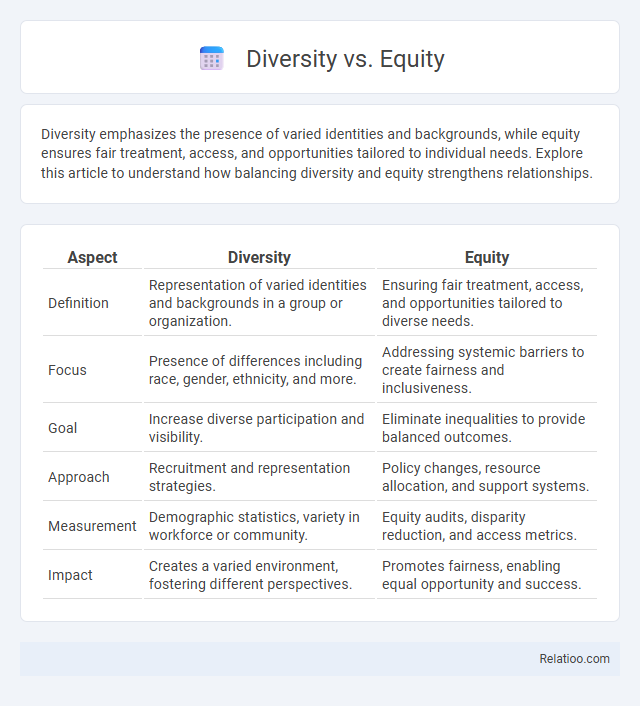Diversity emphasizes the presence of varied identities and backgrounds, while equity ensures fair treatment, access, and opportunities tailored to individual needs. Explore this article to understand how balancing diversity and equity strengthens relationships.
Table of Comparison
| Aspect | Diversity | Equity |
|---|---|---|
| Definition | Representation of varied identities and backgrounds in a group or organization. | Ensuring fair treatment, access, and opportunities tailored to diverse needs. |
| Focus | Presence of differences including race, gender, ethnicity, and more. | Addressing systemic barriers to create fairness and inclusiveness. |
| Goal | Increase diverse participation and visibility. | Eliminate inequalities to provide balanced outcomes. |
| Approach | Recruitment and representation strategies. | Policy changes, resource allocation, and support systems. |
| Measurement | Demographic statistics, variety in workforce or community. | Equity audits, disparity reduction, and access metrics. |
| Impact | Creates a varied environment, fostering different perspectives. | Promotes fairness, enabling equal opportunity and success. |
Understanding Diversity and Equity
Diversity encompasses the presence of different identities, backgrounds, and perspectives within a group, while equity ensures fair treatment, access, and opportunities tailored to individual needs. Understanding diversity helps recognize the variety of experiences and cultures influencing Your environment, and equity addresses systemic barriers to create inclusive outcomes. Focusing on equity rather than equality promotes fairness by acknowledging and accommodating those differences effectively.
Key Differences Between Diversity and Equity
Diversity refers to the presence of varied characteristics within a group, such as race, gender, age, and cultural background, emphasizing representation and inclusion. Equity involves ensuring fair treatment, opportunities, and access to resources by addressing systemic barriers that hinder marginalized groups from achieving equality. The key difference lies in diversity focusing on the composition of a group, while equity targets the fairness of outcomes and opportunities within that group.
Historical Context: The Evolution of the Terms
Diversity, equity, and inclusion (DEI) originated from civil rights movements of the 1960s, evolving to address systemic inequalities in workplaces and education. Diversity initially emphasized representation of various racial, ethnic, and gender groups, while equity emerged later to focus on fair treatment, access, and opportunities tailored to different needs. Inclusion became prominent in the 1990s, highlighting the importance of creating environments where diverse individuals feel valued and able to fully participate.
Why Diversity Alone Isn’t Enough
Diversity refers to the presence of different identities and backgrounds, while equity ensures fair treatment and access to opportunities regardless of those differences. Your organization may have diverse representation, but without equity, systemic barriers and biases can limit true inclusion and belonging. Focusing solely on diversity overlooks the need for equitable policies and practices that empower every individual to succeed.
Equity: Moving Beyond Representation
Equity transcends mere representation by addressing systemic barriers and ensuring fair access to opportunities and resources based on individual needs. Unlike diversity, which focuses on the presence of varied demographic groups, equity emphasizes the restructuring of institutional policies to achieve genuine inclusion and equal outcomes. Prioritizing equity fosters an environment where all individuals, regardless of background, can thrive and contribute meaningfully.
The Role of Bias in Diversity and Equity
Bias significantly impacts both diversity and equity initiatives by influencing the representation and treatment of individuals within organizations. Implicit biases often skew recruitment and promotion processes, hindering true diversity and undermining equitable outcomes. Addressing these biases through training and systemic changes is crucial for fostering inclusive environments where diversity thrives and equity is achieved.
Implementing Equity in Diverse Environments
Implementing equity in diverse environments requires addressing the unique needs and systemic barriers faced by different groups to ensure fair access and opportunities for all. Your strategies should include inclusive policies, culturally responsive practices, and data-driven assessments to measure progress and adjust interventions effectively. Prioritizing equity fosters an environment where diversity is not only recognized but also empowered through justice and inclusion.
Measuring Success: Metrics for Diversity vs Equity
Measuring success in diversity involves metrics like representation rates, demographic percentages, and hiring benchmarks across various groups to ensure a broad spectrum of identities. Equity metrics focus on access to resources, opportunity distribution, pay equity, and outcome-based assessments to determine if systems support fair treatment and advancement. Your organization's ability to analyze both sets of data helps create an inclusive environment by addressing not just who is present, but whether all individuals have equitable chances to thrive.
Common Challenges and Misconceptions
Diversity emphasizes the presence of different identities within a group, equity focuses on providing fair access and opportunities, while inclusion ensures those diverse individuals feel valued and integrated. Common challenges include confusing diversity with equity, leading to surface-level representation without addressing systemic barriers that affect Your ability to succeed. Misconceptions often arise from assuming diversity alone guarantees equity, neglecting the targeted actions required to create truly inclusive environments.
Building Inclusive and Equitable Workplaces
Diversity ensures representation of different identities and perspectives within your workplace, while equity involves creating fair policies and practices that provide equal access to opportunities for all employees. Inclusion focuses on fostering a culture where every individual feels valued, respected, and empowered to contribute their unique talents. Building inclusive and equitable workplaces requires intentional strategies that address systemic barriers and promote belonging to drive innovation and employee engagement.

Infographic: Diversity vs Equity
 relatioo.com
relatioo.com